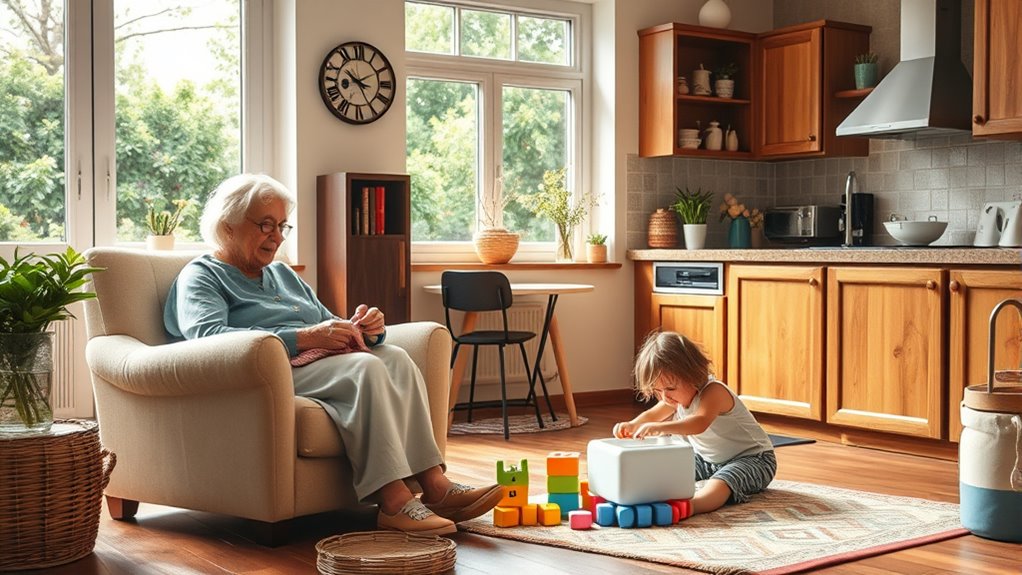Living with multiple generations can save you money by sharing housing costs and bills, while also strengthening cultural traditions and family bonds. It promotes mutual support, distributes responsibilities, and helps preserve your heritage. However, it requires good communication and clear boundaries to prevent conflicts. While it can be rewarding and enriching, understanding both the benefits and challenges is key. Keep exploring to discover how to make multigenerational living work best for your family.
Key Takeaways
- Multigenerational living offers financial benefits by sharing housing costs and pooling resources for savings and emergencies.
- It strengthens cultural bonds, traditions, and intergenerational relationships within families.
- Sharing responsibilities among family members promotes mutual support and reduces individual burdens.
- Effective communication and boundary-setting are essential to navigate potential conflicts and maintain harmony.
- While rewarding, multigenerational living requires thoughtful planning to address challenges and ensure a positive environment.

Have you ever considered how multigenerational living can benefit your family? When different generations share a household, you open the door to numerous advantages that go beyond just saving money. One of the most immediate benefits is the financial aspect. By pooling resources, you can considerably reduce housing costs, including rent or mortgage payments, utilities, and maintenance expenses. Sharing these costs among family members lightens everyone’s financial burden, making it easier to save for future needs or invest in other priorities like education or healthcare. Additionally, with multiple incomes contributing to household expenses, there’s often more flexibility to handle unexpected costs or financial setbacks. This shared financial responsibility helps create a more stable economic environment for everyone involved.
Beyond the monetary advantages, multigenerational living also carries profound cultural significance. Many cultures around the world, especially Asian, Hispanic, and African communities, view living with extended family as a crucial part of their heritage. It reinforces family bonds and promotes a sense of belonging and mutual support. When you live with grandparents, parents, children, and even extended relatives, you’re preserving traditions, passing down stories, and teaching younger generations about their cultural values. This environment fosters respect and understanding across age groups and helps instill a strong sense of identity. For many families, maintaining these cultural practices through shared living arrangements strengthens their roots and keeps traditions alive in a rapidly changing world. Moreover, cultural continuity, which is often supported by multigenerational households, can be reinforced through shared daily routines and celebrations that involve multiple generations. Recognizing the importance of intergenerational bonds can further enhance this shared experience and promote lifelong relationships. Additionally, home organization plays a vital role in creating a functional and harmonious living space for everyone involved.
Furthermore, the shared responsibilities of caring for children and elders can also contribute to a more balanced family life, reducing stress and workload for individual members. While the advantages are compelling, it’s essential to recognize that multigenerational living also requires clear communication, boundaries, and mutual respect. But if approached thoughtfully, it can be a rewarding experience that enriches your family’s financial stability and cultural fabric, creating a strong foundation for future generations.
Frequently Asked Questions
How Does Multigenerational Living Impact Property Taxes?
When you live in a multigenerational household, it can impact your property taxes through the tax assessment process. You might see changes in your property deductions if the property’s value is reassessed or if you qualify for specific exemptions as a primary resident. Sharing the home often means a combined tax burden, but understanding local laws can help you optimize deductions and potentially reduce your property tax liability.
What Are Common Privacy Solutions for Shared Homes?
Ever notice how shared homes can feel a little crowded? You can create more privacy with simple solutions like privacy partitions that divide common spaces or add a sense of personal territory. Soundproofing solutions also help block out noise, giving everyone a bit of quiet time. These small changes make a big difference, helping you enjoy your space while living with others, all without sacrificing comfort or connection.
How Does It Affect Inheritance and Estate Planning?
You should consider how multigenerational living impacts estate distribution and inheritance implications. Sharing a home can complicate estate plans, requiring clear documentation to guarantee your assets are allocated as you intend. It might influence inheritance timing and beneficiaries, especially if assets are jointly owned or transferred within the household. Planning ahead helps prevent disputes and ensures your estate distribution aligns with your wishes, despite the complexities of shared living arrangements.
Are There Specific Legal Considerations for Multigenerational Households?
Did you know nearly 20% of households are multigenerational? You should consider legal documentation to clarify rights and responsibilities and guarantee smooth management. Zoning regulations might restrict or permit such living arrangements, so check local laws beforehand. Being aware of these legal considerations helps protect everyone’s interests, avoiding disputes. Always consult legal professionals to navigate specific rules and ensure your household complies with all regulations, making multigenerational living safer and more harmonious.
How Can Conflicts Be Effectively Managed in Multigenerational Homes?
To effectively manage conflicts in multigenerational homes, you should establish clear family boundaries and encourage open communication. Use communication strategies like active listening and regular family meetings to address issues early. Respect everyone’s needs and perspectives, and set rules that promote harmony. By fostering understanding and maintaining boundaries, you create a positive environment where conflicts are resolved constructively, strengthening family bonds.
Conclusion
Embracing multigenerational living can be a gentle dance of connection and compromise, offering warmth and support in life’s quieter moments. While it brings undeniable closeness, it also requires patience and understanding to navigate the delicate balance. Remember, every shared space is an opportunity to nurture bonds and create lasting memories. With thoughtful communication, this living arrangement can become a beautiful, enriching chapter in your family’s story—full of love, growth, and shared experiences.









